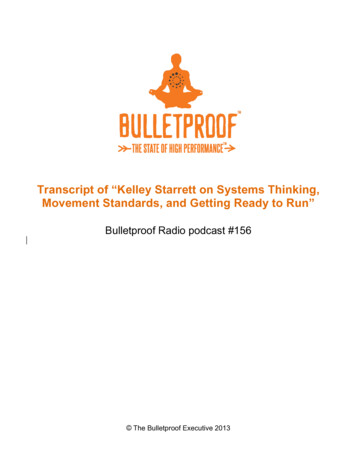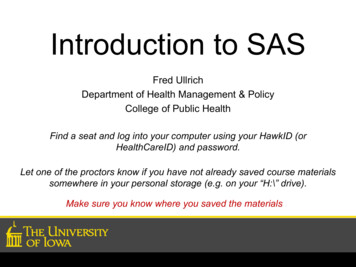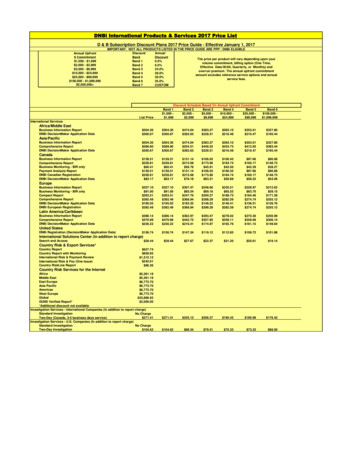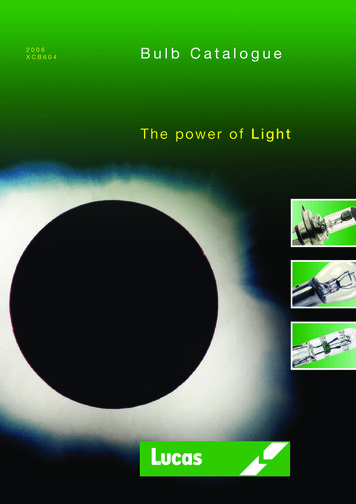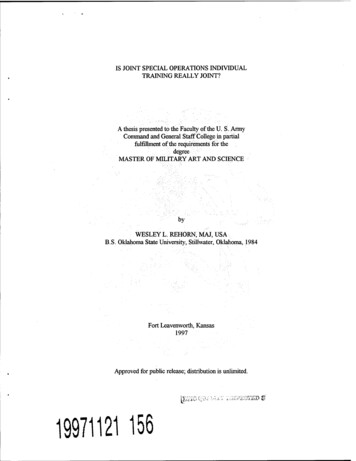
Transcription
IS JOINT SPECIAL OPERATIONS INDIVIDUALTRAINING REALLY JOINT?A thesis presented to the Faculty of the U. S. ArmyCommand and General Staff College in partialfulfillment of the requirements for thedegreeMASTER OF MILITARY ART AND SCIENCEbyWESLEY L. REHÖRN; MAJ, USAB.S. Oklahoma State University, Stillwater, Oklahoma, 1984Fort Leavenworth, Kansas1997Approved for public release; distribution is unlimited.llÄ'i.O i'l -" ' - j- . - t'jL.'Sx'hiD @19971121 156
Form ApprovedOMB No. 0704-0188REPORT DOCUMENTATION PAGEPublic reporting burden for this collection of information is estimated to average 1 hour per response, including the time for reviewing instructions, searching existing data sources,gathering and maintaining the data needed, and completing and reviewing the collection of information. Send comments regarding this burden estimate or any other aspect of thiscollection of information, including suggestions for reducing this burden, to Washington Headquarters Services, Directorate for Information Operations and Reports 1215JeffersonDavis Highway, Suite 1204, Arlington, VA 22202-4302, and to the Office of Management and Budget, Paperwork Reduction Project (0704-0188), Washington DC205031. AGENCY USE ONLY (Leave blank)3. REPORTTYPE AND DATES COVEREDMaster's Thesis, 4 Aug 1996-6 June 19972. REPORTDATE7 June 19974. TITLEAND SUBTITLE5. FUNDINGNUMBERSIs Joint Special Operations Training Really Joint?6, AUTHOR(S)Major Wesley L. Rehorn7. PERFORMINGORGANIZATIONNAME(S)ANDADDRESS(ES)8. PERFORMING ORGANIZATIONREPORTNUMBERU. S. Army Command and General Staff CollegeATTN: ATZL-SWD-GDFort Leavenworth, KS 66027-13529. SPONSORING/ MONITORINGAGENCYNAME(S)ANDADDRESS(ES)10. SPONSORING/ MONITORINGAGENCY REPORTNUMBER11.SUPPLEMENTARYNOTES12a. DISTRIBUTION AVAILABILITY STATEMENT12b. DISTRIBUTIONCODEApproved for public release; distribution is unlimited13. ABSTRACT (Maximum 200 words)This study is an anlaysis of Joint Special Operations Forces (SOF) basic or common skills training. The study uses theUnited States Army Special Warfare Center and School (USAJFKSWCS) as a basis of evaluation of the effectiveness of theDepartment of Defense (DOD) inter service training within United States Special Operations Comand (USSOCOM). Thisthesis evaluates and suggests solutions for the future of joint core basic and advanced skill training and propenency associatedwith this training. This study also evalautes the research, design and fielding of SOF equipment and the equipments integrationin the SOF schools. This thesis concludes that, even with recent improvements, the basic entry level and common advancedskills are being taught with varied techniques, tactics, and procedures (TTP) and each skills objectives remain the individualservices responsibility. The disparity of training objectives leads to a flawed integration of these skills during joint exercisetraining and actual joint missions.14. SUBJECTTERMSSpecial Operations Forces (SOF), Special Forces (SF), SEALS, Rangers , Combat ControlTeams (CCT), Pararescue (PJ), Special Operations Aviation regiment (SOAR), Special WarfareCenter (SWC), High Altitude Low Opening (HALO), Combat Diver17. SECURITYCLASSIFICATIONOF REPORTUNCLASSIFIED18. SECURITYCLASSIFICATIONOF THIS PAGEUNCLASSIFIED19. SECURITYCLASSIFICATIONOF ABSTRACTUNCLASSIFIED15. NUMBER OF PAGES9216. PRICE CODE20. LIMITATIONOF ABSTRACTUNLIMTED
IS JOINT SPECIAL OPERATIONS INDIVIDUALTRAINING REALLY JOINT?A thesis presented to the Faculty of the U. S. ArmyCommand and General Staff College in partialfulfillment of the requirements for thedegreeMASTER OF MILITARY ART AND SCIENCEbyWESLEY L. REHORN, MAJ, USAB.S. Oklahoma State University, Stillwater, Oklahoma, 1984Fort Leavenworth, Kansas1997Approved for public release; distribution is unlimited.CÜJ" 1 t'- "si-!" * j!- -*. ://"'' "f3"T?T'T V
MASTER OF MILITARY ART AND SCIENCETHESIS APPROVAL PAGEName of Candidate: Major Wesley L. RehornThesis Title: Is Joint Special Operations Individual Training Really Joint?Approved by:, Thesis Committee ChairmanMemberMemberAccepted this 6th day of June 1997 by:v/ 7 —, Director, Graduate Degree ProgramsPhilip J. Brookes, Ph.D.The opinions and conclusions expressed herein are those of the student author and do notnecessarily represent the views of the U.S. Army Command and General Staff College or any othergovernmental agency. (References to this study should include the foregoing statement.)ll
ABSTRACTIS JOINT SPECIAL OPERATIONS INDIVIDUAL TRAINING REALLY JOINT? by MAJWesley L. Rehorn, USA, 100 pages.This study is an analysis of Joint Special Operations Forces (SOF) basic or common skillstraining. The study uses the U.S. Army John F. Kennedy Special Warfare Center and School(USAJFKSWCS) as a basis of evaluation of the effectiveness of the Department of Defense(DOD) inter service training (ITRO) process. This study evaluates and suggests solutions for thefuture of joint core skills training and proponency. This study concludes that the basic entry levelofjoint special operations training is, even with recent improvements, an individual service system.Similar basic and advanced skills have varied techniques, tactics, and procedures (TTP) whichleads to a flawed training system and difficult assimilation of joint training exercises and missionaccomplishment.This study provides suggestions on improving the design and implementation of special operationsjoint training for basic and advanced skills. The study also provides suggestions on improvingdesign, testing and fielding of special operations equipment to assist in viable joint initial entrytraining and compatibility of future joint operations.The study provides recommendations on how to redesign the U.S. Special Operations Command(USSOCOM) training development base to incorporate each SOF components need. Each SOFcomponent must align mission analysis, equipment mission need statements, design, development,and procurement to coordinate training resources and objectives.Ill
ACKNOWLEDGMENTSI would like to thank the soldiers, sailors, airmen, and marines that on a daily basis takethe greatest risk of all, training their students 12,500 feet above the ground. Their dedication andcommitment is equaled only by the men and women, military and civilian, of the United States JohnF. Kennedy Special Warfare Center and School who support and train the premier peacemakersand peacekeepers of the Twentieth century.I would also like to thank the three soldiers most responsible for my training andunderstanding of the Special Warfare Training Group (Airborne) (SWTG) (A): COL KennethGetty, former SWTG (A) Commander and Director of Operations for the Joint Special OperationsForces Institute (JSOFI), who retired in October 1996 after successfully meeting the challenge ofevery difficult job that Special Forces had to offer; CSM (Ret) David L. Clark, who has served hiscountry admirably for over thirty five years in the 82d Airborne and Special Forces, on active dutyand over 10 years as a civilian employee; and 1SG Paul Gann who brought humor, understanding,and experience to leading the NCOs of the Military Freefall School (MFFS), Co. B, 2d Bn, 1stSWTG (A).Lastly I thank my wife, Charlene, and children, Leia and Steyer. Who at the beginning ofevery assignment are led to believe that this is the assignment in which I will spend more time athome.iv
TABLE OF CONTENTSPageAPPROVAL PAGEiiABSTRACTiiiACKNOWLEDGMENTSivLIST OF ACRONYMSvCHAPTER1. INTRODUCTION12. THE JOINT SPECIAL OPERATIONS TRAINING BASE193. REGULATORY GUIDANCE FOR JOINT TRAINING424. DESIGN OF COURSES AND STANDARDS525. THE FUTURE OF SPECIAL OPERATIONS TRAINING70APPENDIX81BIBLIOGRAPHY86INITIAL DISTRIBUTION LIST89
LIST OF ACRONYMSAETCAir Force Education Training CenterAFAir ForceAFSOCAir Force Special Operations CommandAMFFPCAdvanced Military Free Fall Parachutist CourseAODAutomatic Opening DeviceAPADSAerial Precision Deliver SystemARIArmy Research InstituteARSOFArmy Special Operations ForcesASTSAdvance Skills Training SystemATRRSU.S. Army Training Requirements and Resources SystemBODBoard of DirectorsBUDSBasic Underwater DemolitionCAConcepts AnalysisCCTCombat Control TeamCDCombat DevelopmentCDCCombat Diver CourseCDQCCombat Diver Qualifications CourseCDSCCombat Diver Supervisor CourseCFCCombat Fighting CourseCGCommanding GeneralVI
CGSCU.S. Army Command & General Staff CollegeCINCCommander in ChiefCMFCareer Management FieldCOICourse of InstructionCQBClose Quarters BattleCRBCurriculum Review BoardCTCounterterrorismCTSBCritical Task Selection Board.DADirect ActionDCDDirectorate of Combat DevelopmentsDCSOPSDeputy Chief of Staff for OperationsDCSRIDeputy Chief of Staff for Resource IntegrationDDSDry Deck ShelterDMTDive Maintenance TechnicianDODDepartment of DefenseDOTDDirectorate of Training and DoctrineDOTMLSDoctrine Organization Training Manning Leadership SystemsDZDrop ZoneEESDExternal Evaluation and Standardization DivisionEMTEmergency Medical TechniciansFFMFull-Face MaskFIDForeign Internal DevelopmentFMField ManualGPSGlobal Positioning SystemVll
HAHOHigh Altitude High Opening-HALOHigh Altitude Low OpeningICTIntegrated Concept TeamsIESDInternal Evaluation and Standardization DivisionINTACIndividual Terrorist awareness CourseITROInter service Training Review OrganizationJMJump MasterJMPIJumpmaster Pre InspectionJRTCJoint Readiness Training CenterJSCPJoint Strategic Contingency PlanJSOCJoint Special Operations CommandJSOCRBJoint Special Operations Curriculum Review BoardsJSOFIJoint Special Operations Forces InstituteJSOTFJoint Special Operations Task ForceJSSAJoint Service SERE AgencyJSTARSJoint Surveillance Target Attack Radar SystemJTTPJoint Tactics, Techniques, and ProceduresMAAMission Area AnalysisMAROPSMaritime OperationsMETLMission Essential Task ListMEUMarine Expeditionary UnitsMFFJMMilitary Free Fall JumpmasterMFFPCMilitary Free Fall Parachutist CourseMFFSMilitary Freefall Schoolvm
MNSMission Need StatementsMOSMilitary Occupations SpecialtyMSTMission Supporting TasksMTTMobile Training Team-MTVSMilitary Tandem Vector SystemNAVSPECWARCENNavy Special Warfare Center and SchoolNCONoncommissioned officerNSWNaval Special WarfareNSWCNavy Special Warfare CenterNTCNational Training CenterODAOperational Detachment AlphaOJTOn the Job TrainingPJPara-rescuePMEProfessional Military EducationPOIProgram of InstructionPSYOPPsychological OperationsRAPTRam Air Parachute TransitionRIPRanger Indoctrination ProgramROPRanger Orientation ProgramSCUBASelf-contained Underwater Breathing ApparatusSDASEAL Delivery VehicleSEALSea, Air, Land TeamSERESurvival, Escape, Resistance and EvasionSFSpecial ForcesIX
SFARTAETCSpecial Forces Advanced Reconnaissance, Target Analysis, andExploitation CourseSFGSpecial Forces GroupSFODASpecial Forces Operation Detachment ASMDRStructure and Manning Decision ReviewSMESubject Matter ExpertSMUSpecial Mission UnitSOSpecial OperationsSOARSpecial Operations Aviation RegimentSOFSpecial Operations ForcesSOFUSpecial Operations Forces UniversitySOMTCSpecial Operations Medical Training CenterSOPStandard Operating ProceduresSOTSpecial Operations TechnicianSOTICSpecial Operations Target Interdiction CourseSWSSEAL Weapons SystemSWTGSpecial Warfare Training GroupTCTraining CircularTDATable of Distribution and AllowancesTOETable of Organization and EquipmentTRADOCTraining and Doctrine CommandTRAPTraining Resource Arbitration PlanTTPTechniques, Tactics, and ProceduresUBAUnderwater Breathing Apparatus
-UDTUnderwater Demolition TeamUSAFSOSU.S. Air Force Special Operations SchoolUSAJFKSWCSU.S. Army John F. Kennedy Special Warfare Center and SchoolUSASFCU.S. Army Special Forces CommandUSASOCU. S. Army Special Operations CommandUSCINCSOCU.S. Special Operations CommandUSNU. S. NavyUSSOCOMU. S. Special Operations CommandVWTVertical Wind TunnelWICWater Infiltration CourseXl
CHAPTER 1INTRODUCTIONThe goal of all training should be to prepare a unit to accomplish its tasks in such a mannerthat execution in war or peace becomes simply an extension of the training exercises.1USSOCOM Publication 1, Special Operations in Peace and WarIntroductionThe lack of Special Operations Forces (SOF) interoperability in mission profiles, training,and equipment development, identified by the Holloway Commission back in 1980, still exists in1997. The Holloway Commission was a result of the Desert One operation that FM 100-25describes:On 24 April 1980 about 180 members of a U.S. (sic) Joint Special Operations Task Force(JSOTF) infiltrated Iran by air to rescue 53 Americans held hostage in Tehran. At DesertOne, a secret landing strip 265 nautical miles from Tehran, the on-scene commander had toabort the mission because three of his eight RH-53D helicopters were unable to continuethe mission. As the exfiltration began, one of the remaining helicopters crashed into a C130 transport plane on the ground. Eight men died in the ensuing fire and explosions. Theremaining JSOTF members flew to safety.2The aborted attempt to rescue the hostages held by the Iranians brought the lack of-interoperability to the forefront. Although the poor joint interoperability existed prior to 1980, theHolloway Commission findings and recommendations highlighted the issue.3The HollowayCommission specifically stated, 'Training was planned and conducted on a highly decentralizedbasis within an informal component command structure that does not appear to have been clearlyestablished."4 The rescue attempt was also the genesis of the Joint Special Operations Command(JSOC), a joint command designed to combine the best of each service's Special Operations (SO)tactics, techniques, and procedures (TIP). Unfortunately, JSOC has become the cornerstone issue1
for many politicians looking for less inter-servicc rivalry and more efficiency and impact for thedollar. One of the problem areas that the Holloway Commission identified, which was the lack of acentralized mission training plan or agency, still exists within Special Operations Forces (SOF)today. The quote from the mission after action review: "Individual and unit training was conductedand evaluated throughout the period at widely separated locations"5 still applies to SOF trainingtoday. Not only are the training bases separated by geography, but also by objective, mission, androles. Many people, both in government and the military, were under the impression that JSOCwould develop into the training panacea for joint interoperability. However, at the SpecialOperations in U.S. Strategy symposium held in 1983, attendees noted thatinter-scrvice rivalries became evident when the U.S. Army decided to develop a SCUBA(Self Contained Underwater Breathing Apparatus) capability for operations in inlandwaterways to include caching and other activities. The Navy questioned that programbecause underwater work is normally the domain of the Navy's Sea, Air, Land Team(SEAL) and Underwater Demolition Team (UDT). Similarly the U.S. Army wondered whythe Navy SEAL had to be a parachutist.6Why, with the problem of incompatibility being identified even earlier than the 1983symposium, the recurring incompatibility problems exist to this day is difficult to understand. Thecompatibility of the Army's, Nan's, and Air Force's equipment, training, and doctrine forsomething as simple as SCUBA and High Altitude Low Opening (HALO), continues to be aproblem in 1997. Many mistakenly thought JSOC would serve in deconflicting different servicetraining and equipment anomalies, since that issue was identified as being at the crux of Desert One.In addition, the mission of JSOC docs include activities towards developing training and doctrine.However, the Department of Defense designed JSOC as a joint standing operational headquarters todeal with crisis and contingencies and not to supervise or act as a clearinghouse for joint trainingissues. JSOC was never envisioned and should not be responsible for aligning the SOF trainingbase. JSOC issues training guidance to units over which it has operational control and TTPrequired meeting deployment criteria. However, the overall coordination of training remains theresponsibility of United States Special Operations Command (USSOCOM).2
The coordination problem is not at the operator level, although healthy interservice rivalriesexist among different branches of SOF. In reality, the problem exists due of the lack of a functionalagency or system that coordinates joint individual training. Many feel the friction among seniorlevel leadership, where budget and missions are at stake, prevents a more amalgamated trainingsystem. Actually the major impediment to consolidating training is not the senior operationalleadership. The real conflict occurs at the bureaucratic level where services compete for roles,missions, and dollars. In his paper Military Capabilities and Special Operations in the 1980 's,published in 1983, Roger M. Pezzele noted: "there is always cooperation in action at the workinglevel; the symptoms of inter-service rivalries are more noticeable, and indeed real, at seniorechelons."7 Operator level cooperation remains the strongest link between service SO personnel.Upon his retirement in 1996, the former Commanding General of United States ArmySpecial Operations Command (USASOC), Lieutenant General James T. Scott stated that "thetoughest thing to get by is parochialism in the schools."8 Lieutenant General Scott had the uniqueopportunity to oversee the development of Joint Special Operations Forces Institute (JSOFI), theamalgamation of the Military Free Fall School (MFFS), and the expansion of the U.S. Army CombatDiver Course (CDC) in Key West, Florida.Even in March 1983 both politicians and military leaders knew that for both missionaccomplishment and the survival of the military budget, joint training was here to stay. The missionstatement for the 1983 Special Operations in US Strategy Symposium met with the purpose to firstexamine how special operations can complement an effective "conventional" defensecapability; and second, to determine the means by which special operations could belegitimized as a crucial element in national security policy9One of the studies from the symposium, written by Roger M. Pezzele and co-authored byEdward N. Luttwak and Michael D. Healy, states:Inter-service cooperation is probably more vital in special operations than in most otherareas of military activity. Special operations, by their nature, are almost always joint orcollaborative undertakings. It is difficult to envision a ground/surface special operationsmission of extended duration that does not require Air Force support.because joint3
operations can be very complex, they demand organization, teamwork, planning, andpractice-preferably, all on a continuing basis as part of an integrated joint force.10With the predominant theme of the symposium being cooperation, leadership vision, andtraining, why has the development or initiation of an agency like JSOFI taken so long? Theteamwork that Ed Luttwak refers to is very evident on a visit to USSOCOM, which is the unifiedcombatant command designated to man, train, and equip SO forces for utilization by the fiveregional CINCs in support of their theater strategies. The joint flavor of USSOCOM is veryprevalent. However, the complexity and teamwork do not always pay dividends at the operator levelwhen SO forces intermix. For example, a simple high altitude high opening (HAHO) infiltrationraises the problems of: (1) the definition of what the Air Force considers crew rest for parachutists;(2) the altitudes at which parachutists of each service must use oxygen; (3) the regulations whichcover each service's oxygen equipment; (4) which automatic opening device must be used and atwhat setting each service prescribes their use, if any; and (5) the discrepancies between thedefinitions of a HALO jump run.In Operation URGENT FURY, the lack of a single point of contact for static line airborneoperations led to catastrophic results.Part of die problem was that the aircrews were inexperienced; the)' had never practiced thistype of operation under these circumstances. They were not well versed in the techniques,and one aircraft dropped well wide of the ship."A static line infiltration is one of the easiest types of airborne infiltrations to coordinate andexecute. If one can imagine the problems associated with conducting HALO operations, where theDrop Zone (DZ) is often one-hundredth the size of a static line DZ, one can begin to appreciate theneed for joint training at the lowest level.These are but a few anomalies that prevent true joint service HALO operations. Thesedifferences exist in other skills and tasks as well as HALO. Since even in 1983 Ed Luttwak andmany participants at the symposium believed that joint military missions were the basis of the
majority of future operation, why does SOF still have a disparate training base and nonstandardizedTTPs for similar tasks?Congress passed legislative instruments to ensure that services fully participated in jointbillet assignments with quality officers and noncommissioned officers (NCOs) in mid-to-uppergrade joint positions.Congress and the Department of Defense (DOD) went so far as to setprerequisites for nomination and ultimate assignment to joint billets. Congress even mandatedcertain joint training as required for promotion to specific positions and set the promotions in gradeof joint specialty officers equal to or greater than service promotion rates. This last action made ajoint tour a little more palatable for officers not following the service approved career pattern.However, all of the attention on joint training has focused on the senior staff echelons and jointexercises. Many efforts are currently underway to combine facilities, resources, and training bases.Two examples of vision in joint individual training are the Special Operations Medical TrainingCenter (SOMTC) opened recently at Fort Bragg, North Carolina, and the MFFS recently moved toYuma Proving Ground, Arizona. Technically the term "joint individual training'' is a misnomer,since each service is responsible for its own individual training. However, in the area of SOF,individual training is often conducted by other services. As an example, the MFFS recentlyincorporated all four services, in the training of HALO/HAHO parachute training, with instructorsand students coming from all of the services. This formal consolidation has lead to a reduction infacility duplication, the opening of a viable dialogue to derive a true joint-service TTP and results inimproved joint interoperability. It is imperative that SOF continues with the amalgamation oftraining of other skill bases because as Roger Pezzele states: "During the balance of the 1980's andinto the 1990's, special operations units must be capable of flawless joint performance in peacetimeand at all levels of war, whether in foreign internal defense (collective security), rstrategic
Without a standardized base of initial training each skill will develop into a separate TIP.making the "flawless joint performance" Roger Pezzele speaks of more difficult to execute inmission conditions than necessary. The margin for error for SOF has decreased considerably.Increased media coverage gives the public availability of almost real-time video. With this realtime feed, the public and political involvement in SO has increased. Even the successful extractionof belligerents supporting the warlord Muhammad Rarid Aideed in Somalia gave the impression tomany Americans that the mission was a total failure. True, there were casualties, but combat is not aperfect science. The mission in all military views was a qualified success, but the resulting clamorby politicians left no doubt to the military that anything less than perfection was be acceptable. Noone in the military accepts any death, in training or combat, as acceptable. However, leaders mustask the question, Are troops being trained to the highest standards possible to prevent unnecessaryrisks? The facts just do not support the idea that SOF, as a whole, is fully integrated in joint trainingor in the maintenance of those skills to the degree that SOFs require. A case in point is that, of thefive active component Special Forces groups, at the time each of which had nine MFF teams, howmany teams at any one time were level one qualified, or fully mission deployable during thecalendar year'' Due to the requirements of the number of jumps, the support of Air Force aircraft,and limitations on equipment and command support, very few MFF teams reached the highest levelof readiness at least one time in the year. Maintaining the quarterly training requirements to stay atlevel one or real-world combat certified was even more difficult. Taking into consideration the factthat some missions may entail dealing with weapons of mass destruction, can the joint militaryignore the basic individual operator training required to accomplish the mission?PurposeThe purpose of this thesis is to show, using the 2d Battalion 1st Special Warfare TrainingGroup (Airborne) (SWTG) (A) as a basis of analysis, how improvements can be made to improvethe SOF joint training base. The thesis is important because it explains how the SOF training base6
can train forces to a higher standard, with less of a training base and at less cost. The paperaddresses additional issues of equipment development, fielding, and operational miscues based onnonintegrated research design and development systems. However, the examples of equipmentproblems and operational difficulties all relate directly back to the training base. Many of these-issues were encountered in successive tours as the Battalion Operations Officer and Commander ofB Company of the MFFS. The officers and NCOs of these organizations know these issues welland deal with them on a daily basis and epitomize the quote made in 1983: "Even when missionplanning from on high was obviously weak, and support and cooperation from conventional forceslacked the proper selection, training and leadership carried the day" (Italics mine).13The hallmark for SOF is the level of training and scope of expertise. The core of SOF'sexistence in the future will be the variety of missions and contingencies in which they will beexpected to participate. Quality training cannot be sacrifices due to budget cuts and "downsizing."No matter the assigned mission, or the leadership, that SOF is working for, be it US, NATO, UNcommanders, U.S. SOFs must remain the best-trained tool of choice in crisis or contingencyoperations. They must lead the way in the world, SOF as the true professionals—the standards uponall others gauge themselves.AssumptionsIn conducting this study the researcher has made the following assumptions:1. The United States will continue to require a joint SO capability.2. That the world situation will continue to be characterized by uncertainty withincreasing low intensity conflicts based on political, ideological, tribal or religious or eveneconomic or resource based reasons.3. SOF assessment, selection and intensive training will ensure the high quality of recruitsand operators required for SOF success.4. The personnel SOF assesses and selects will remain the cornerstones of its success.7
And last but not least that the SOF truths remain as valid in the future as they do for today:1. Humans are more important than hardware.2. Quality is better than quantity.3.SOF cannot be mass-produced.4. Competent SOF cannot be created after emergencies occur.Definitions of TermsAdvanced Skills Training System (ASTS) ASTS is normally associated with experiencedSOF operators requiring repetitive training to maintain proficiency in HALO, SCUBA, Sniper orClose Quarters Battle (CQB).Class A class is numbered iteration of a course for a given number of students or trainees.Collocated A collocated course is a course used by one or more services on anotherservice's installation with shared classroom facilities and equipment. Training policies andcurriculum are determined by the host service.Instructor requirements are calculated by theparticipating services and provided to meet their needs.Consolidated A course consisting of a curriculum developed by two or more services. Thefaculty is normally multi-service. The curriculum may be common throughout or consist of acommon core plus service unique tracks. Training policies, directives, and materials are determined-by mutual agreement among the services.Instructor requirements arc calculated on an ITROformula that fairly shares the requirements among the participating services.Course A formal program of instruction that is identified by an assigned course number.14Course of Instruction (COD A series of POI linked with an ultimate objective to train anindividual or collective skill.High Altitude High Opening (HAHO)Similar to HALO with the exception that theopening altitude is up to 17,500 feet AGL feet in the training environment.8
High Altitude Low Opening Parachuting (HALO) Infiltration technique used with RAMair parachute. Training opening altitudes of 4,000 feet above ground level (AGL).Individual Training Instruction given to qualify an individual for a needed military skill orto enhance such a skill by providing additional practice or supporting knowledge.15Inter-service Training Review Organization (TTRO) An organization of military servicesset up to improve the cost effectiveness and efficiency through course consolidations or collocationsand standardization. There are three types of ITRO courses, collocated, consolidated, and quota.Military Occupational Specialty Training Training that awards a Military OccupationsSpecialty (MOS) to warrant officer or enlisted personnel upon successful completion of thecourse.16Mission Letter A letter or order ou
SEAL SERE SF Mission Need Statements Military Occupations Specialty Supporting Tasks Mobile Training Team Military Tandem Vector System Navy Special Warfare Center and School Noncommissioned officer Naval Special Warfare Navy Special Warfare Center National Training Center Operational Detachme


